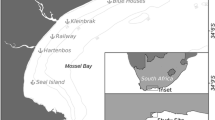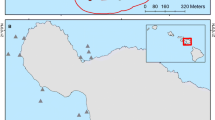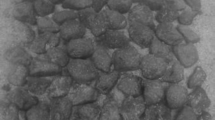Abstract
Refugia play an important role in shaping predator/prey interactions; however, few studies have investigated predator–prey relationships between large marine vertebrates, mainly due to the logistical challenges of studying marine species. The predictable interactions between Cape fur seals and white sharks in South Africa at two neighbouring seal colonies (Seal Island and Geyser Rock) with similar breeding conditions, but distinct adjacent seascapes, offer an opportunity to address this gap. Geyser Rock differs from Seal Island in being surrounded by abundant refugia in the form of kelp beds and shallow reefs, while Seal Island is mostly surrounded by deep open water. In this study, we compare data collected from Geyser Rock to the published data at Seal Island and ask, do seals adjust their anti-predator tactics as a function of landscape features? We found that during periods of high white shark presence, seals at Geyser Rock reduced their presence in open-water and utilized areas that contained complex landscapes around the colony. Although seals at Geyser Rock formed groups when traversing open water, neither group size (high risk median = 4, low risk median = 5) nor temporal movement patterns varied significantly with white shark presence as has been shown at Seal Island. Furthermore, recorded hourly predation rates at Seal Island were 12.5 times higher than at Geyser Rock. Together, these findings suggest that refuge use may be the more effective anti-predator response of seals to a seasonally abundant predator and that the predations at Seal Island reflect a comparative lack of refugia.









Similar content being viewed by others
References
Anderson SD, Henderson RP, Pyle P, Ainley DG (1996) White shark reactions to unbaited decoys. In: Klimley AP, Ainley DG (eds) The Biology of Carcharodon carcharias. Academic, San Diego, CA, pp 223–228
Bergerud AT (1988) Caribou, wolves and man. Trends Ecol Evol 3:68–72
Brown JS, Kotler BP (2004) Hazardous duty pay and the foraging cost of predation. Ecol Lett 7:999–1014
Caro TM (1994) Cheetahs of the Serengeti Plains: group living in an asocial species. University of Chicago Press, Chicago
Crowder LB, Cooper WE (1982) Habitat structural complexity and the interaction between bluegills and their prey. Ecology 63:1802–1813
de Vos A (2010) Being breakfast: anti-predator behaviour of Cape fur seals Arctocephalus pusillus pusillus in relation to exceptional predation by white sharks Carcharodon carcharias around Seal Island, False Bay, South Africa. Doctoral dissertation, University of Cape Town
de Vos A, O'Riain MJ (2010) Sharks shape the geometry of a selfish seal herd: experimental evidence from seal decoys. Biol Lett 6:48–50
Dill LM, Heithaus MR, Walters CJ (2003) Behaviourally mediated indirect interactions in marine communities and their conservation implications. Ecology 84:1151–1157
Fallows C, Martin RA, Hammerschlag N (2012) Comparisons between white shark-pinniped interactions at Seal Island (South Africa) with other sites in California. In: Domeier ML (ed) Global Perspectives on the Biology and Life History of the White Shark. CRC Press, Boca Raton, FL, pp 105–117
Gotceitas V, Colgan P (1990) The effects of prey availability and predation risk on habitat selection by juvenile bluegill sunfish. Copeia 1990:409–417
Hammerschlag N, Martin RA, Fallows C (2006) Effects of environmental conditions on predator–prey interactions between white sharks (Carcharodon carcharias) and Cape fur seals (Arctocephalus pusillus pusillus) at Seal Island, South Africa. Environ Biol Fish 76:341–350
Hammerschlag N, Gallagher AJ, Lazarre DM (2011) A review of shark satellite tagging studies. J Exp Mar Biol Ecol 398:1–8
Hammerschlag N, Martin RA, Fallows C, Collier RS, Lawrence R (2012) Investigatory behaviour toward surface objects and noncomsumptive strikes on seabirds by white sharks, Carcharodon carcharias, at Seal Island, South Africa (1997–2010). In: Domeier ML (ed) Global Perspectives on the Biology and Life History of the White Shark. CRC Press, Boca Raton, FL, pp 91–103
Heck KL, Crowder LB (1991) Habitat structure and predator–prey interactions in vegetated aquatic systems. In: Bell SS, McCoy ED, Mushinsky HR (eds) Habitat Structure: The Physical Arrangement of Objects in Space. Chapman and Hall, New York, New York, pp 282–299
Heithaus MR, Dill LM (2006) Does tiger shark predation risk influence foraging habitat use by bottlenose dolphins at multiple spatial scales? Oikos 114:257–264
Heithaus MR, Hamilton IM, Wirsing AJ, Dill LM (2006) Validation of a randomization procedure to assess animal habitat preferences: microhabitat use of tiger sharks in a seagrass ecosystem. J Anim Ecol 75:666–676
Heithaus MR, Wirsing AJ, Burkholder D, Thomson J, Dill LM (2008) Towards a predictive framework for predator risk effects: the interaction of landscape features and prey escape tactics. J Anim Ecol 78:556–562
Hill JM, Weissburg MJ (2013) Habitat complexity and predator size mediate interactions between intraguild blue crab predators and mud crab prey in oyster reefs. Mar Ecol Prog Ser 488:209–219
Holbrook SJ, Schmitt RJ (1988) The combined effects of predation risk and food reward on patch selection. Ecology 69:125–134
Hugie DM, Dill LM (1994) Fish and game—a game theoretic approach to habitat selection by predators and prey. J Fish Biol 45:151–169
Jewell OJD, Wcisel MA, Towner AV, Chivell W, van der Merve L, Bester MN (2014) Core habitat use of an apex predator in a complex marine landscape. Mar Ecol Prog Ser 506:231–242
Johnson RL, Keswick T, Bester MN, Oosthuizen WH (2009) Encounters between white sharks and Cape fur seals in a shallow channel. Mar Biodiv Rec 2:1–5
Kauffman MJ, Varley N, Smith DW, Stahler DR, MacNulty DR, Boyce MS (2007) Landscape heterogeneity shapes predation in a newly restored predator–prey system. Ecol Lett 10:690–700
Klimley AP (1994) The predatory behavior of the white shark. Am Sci 82:122–133
Kock AA (2014) Behavioural ecology of white sharks Carcharodon carcharias in False Bay, South Africa: towards improved management and conservation of a threatened apex predator. Doctoral dissertation, University of Cape Town
Kock AA, O’Riain MJ, Mauff K, Meÿer M, Kotze D, Griffiths C (2013) Residency, habitat use and sexual segregation of white sharks, Carcharodon carcharias, in False Bay, South Africa. PLoS ONE 8:e55048
Kruuk H (1972) The spotted hyena: a study of predation and social behaviour. University of Chicago Press, Chicago
LaRoche RL, Kock AA, Dill LM, Oosthuizen WH (2008) Running the gauntlet: a predator prey game between sharks and two age classes of seals. Anim Behav 76:1901–1917
Laundré JW, Hernández L (2003) Winter hunting habitat of pumas Puma concolor in northwestern Utah and southern Idaho, USA. Wildlife Biol 9:123–129
Laundré JW, Hernandez L, Altendorf KB (2001) Wolves, elk, and bison: re-establishing the ‘landscape of fear’ in Yellowstone National Park, USA. Can J Zool 79:1401–1409
Laundré JW, Hernandez L, Ripple WJ (2010) The landscape of fear: ecological implications of being afraid. Open Ecol J 3:1–7
Laundré JW, Hernández L, Medina PL, Campanella A, López-Portillo J, González-Romero A, Grajales-Tam KM, Burke AM, Browning DM (2014) The landscape of fear: the missing link to understand top-down and bottom-up controls of prey abundance? Ecology 95:1141–1152
Le Boeuf BJ (2004) Hunting and migratory movements of white sharks in the eastern North Pacific. Mem Natl Inst Polar Res Spec Issue 58:89–100
Lima SL (1992) Strong preferences for apparently dangerous habitats? A consequence of differential escape from predators. Oikos 64:597–600
Lima SL (1998) Stress and decision making under the risk of predation: recent developments from behavioral, reproductive, and ecological perspectives. Adv Stud Behav 27:215–290
Lima SL, Dill LM (1990) Behavioral decisions made under the risk of predation: a review and prospectus. Can J Zool 68:619–640
Mangel M, Clark CW (1986) Towards a unified foraging theory. Ecology 67:1127–1138
Martin RA, Hammerschlag N (2012) Marine predator–prey contests: ambush and speed versus vigilance and agility. Mar Biol Res 8:90–94
Martin RA, Hammerschlag N, Collier RS, Fallows C (2005) Predatory behaviour of white sharks (Carcharodon carcharias) at Seal Island, South Africa. J Mar Biol Assoc UK 85:1121–1135
Martin RA, Rossmo DK, Hammerschlag N (2009) Hunting patterns and geographic profiling of white shark predation. J Zool 279:111–118
McCoy ED, Bell SS (1991) Habitat structure: the evolution and diversification of a complex topic. In: Bell SS, McCoy ED, Mushinsky HR (eds) Habitat Structure: The Physical Arrangement of Objects in Space. Chapman and Hall, New York, pp 3–27
Mech LD (1966) The wolves of Isle Royale. U.S. National Parks Fauna Series No. 7. Government Printing Office, Washington, D.C.
Orth RJ, Heck KL, van Montfrans J (1984) Faunal communities in seagrass beds: a review of the influence of plant structure and prey characteristics on predator–prey relationships. Estuaries 7:339–350
Packer C, Scheel D, Pusey AE (1990) Why lions form groups: food is not enough. Am Nat 136:1–19
Paine RT (1969) The Pisaster–Tegula interaction: prey patches, predator food preference, and intertidal community structure. Ecology 950–961
Preisser EL, Bolnick DI, Benard MF (2005) Scared to death? The effects of intimidation and consumption in predator–prey interactions. Ecology 86:501–509
Schaller JB (1972) The Serengeti lion: a study of predator prey relations. University of Chicago Press, Chicago
Schleyer MH, Heikoop JM, Risk MJ (2006) A benthic survey of Aliwal Shoal and assessment of the effects of a wood pulp effluent on the reef. Mar Pollut Bull 52:503–514
Schoener TW (1971) Theory of feeding strategies. Annu Rev Ecol Syst 2:369–404
Scyphers SB, Powers SP (2013) Context-dependent effects of a marine ecosystem engineer on predator–prey interactions. Mar Ecol Prog Ser 491:295–301
Strong WR (1996) Shape discrimination and visual predatory tactics in white sharks. In: Klimley AP and Ainley DG (eds) The biology of Carcharodon carcharias. Academic Press: San Diego, CA, pp 229–240
Tait KJ, Hovel KA (2012) Do predation risk and food availability modify prey and mesopredator microhabitat selection in eelgrass (Zostera marina) habitats? J Exp Mar Biol Ecol 426:60–67
Taylor RJ (1984) Predation. Chapman & Hall, London, England
Townend J (2002) Practical statistics for environmental and biological scientists. John Wiley & Sons Ltd, West Sussex, England
Towner AV, Wcisel MA, Reisinger RR, Edwards D, Jewell OJ (2013) Gauging the threat: the first population estimate for white sharks in South Africa using photo identification and automated software. PLoS ONE 8:e66035
Troell M, Robertson-Andersson D, Anderson RJ, Bolton JJ, Maneveldt G, Halling C, Probyn T (2006) Abalone farming in South Africa: an overview with perspectives on kelp resources, abalone feed, potential for on-farm seaweed production and socio-economic importance. Aquaculture 257:266–281
Trussell GC, Ewanchuk PJ, Matassa CM (2006) Habitat effects on the relative importance of trait and density mediated indirect interactions. Ecol Lett 9:1245–1252
Weng KC, Castilho PC, Morrissette JM, Landeira-Fernandez AM, Holts DB, Schallert RJ, Goldman KJ, Block BA (2005) Satellite tagging and cardiac physiology reveal niche expansion in salmon sharks. Science 310:104–106
Wernberg T, Smale DA, Tuya F, Thomsen MS, Langlois TJ, de Bettignies T, Bennett S, Rousseaux CS (2013) An extreme climatic event alters marine ecosystem structure in a global biodiversity hotspot. Nat Clim Chang 3:78–82
Wilcoxon F, Katti SK, Wilcox RA (1963) Critical values and probability levels for the Wilcoxon rank-sum test and the Wilcoxon signed rank test. American Cyanamid Comp, Pearl River, New York
Wildlife Computers (2014) FAQ Argos. http://www.argos-system.org/web/en/78-faq.php#faq-theme-55 Accessed 12 June 2014
Willems EP, Hill RA (2009) Predator-specific landscapes of fear and resource distribution: effects on spatial range. Ecology 90:546–555
Wirsing AJ, Heithaus MR, Dill LM (2007) Living on the edge: dugongs prefer to forage in microhabitats that allow escape from rather than avoidance of predators. Anim Behav 74:93–101
Wirsing AJ, Cameron KE, Heithaus MR (2010) Spatial responses to predators vary with prey escape mode. Anim Behav 79:531–537
Acknowledgments
This research was funded by the Dyer Island Conservation Trust (www.DICT.org.za) and supported by Volkswagen South Africa (www.VW.co.za). Many thanks to everyone at The Great White House, Dyer Island Cruises and Marine Dynamics in Gansbaai, South Africa, for supporting this research; with special thanks to Mike Gibbs, Susan Visagie, Brenda du Toit, Albert Scholtz, Pieter du Toit, Kira Matiwane, ‘Star’, Lalo Saidy, Frank Pey, Hennie Otto, Dickey Chivell and Oliver Jewell—for recording ‘A LOT’ of seals.
Ethical standards
This research was approved by the South African Department of Environmental Affairs permit number RES2012/03 and operated under the guidelines of section 83 of the Marine Living Resources Act No. 18 of 1996. Research ethics were reviewed and approved by the University of Cape Town Animal Ethics Committee.
Author information
Authors and Affiliations
Corresponding author
Additional information
Communicated by S. D. Twiss
Rights and permissions
About this article
Cite this article
Wcisel, M., O’Riain, M.J., de Vos, A. et al. The role of refugia in reducing predation risk for Cape fur seals by white sharks. Behav Ecol Sociobiol 69, 127–138 (2015). https://doi.org/10.1007/s00265-014-1825-5
Received:
Revised:
Accepted:
Published:
Issue Date:
DOI: https://doi.org/10.1007/s00265-014-1825-5




